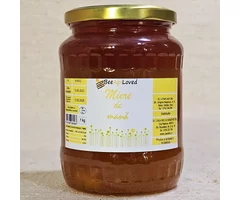Honey is obtained from the nectar of plants, from sweet juices secreted by plants or from the excretions of insects that feed and live on plants and collects by bees. Mixture with certain substances from the salivary glands of bees, they transform the nectar and after they stored in honeycombs, then the excess water evaporates through vibrational movements of the wings of young bees in the hive. After bees leave honey to be matureted in honeycombs.
It is an energizing concentrate of carbohydrates (sugars), predominantly fructose and glucose. It also contains small amounts of sucrose, a maximum of 18% water, organic acids, enzymes. Crystallization is a natural process and depends on the glucose-fructose ratio. Aprons that contain more glucose will crystallize very quickly.
In correcting nutritional deficiencies, in states of physical and mental fatigue, in convalescence after various consumptive diseases, in hepatitis, honey in combination with other products of the hive is wonderful!
Used externally, in the treatment of open wounds, honey has a bacteriostatic, bactericidal, antiseptic, calming effect. Being a dehydrated nectar, it "sucks" water and toxic liquid from the wound, the beneficial effects being quickly.

















